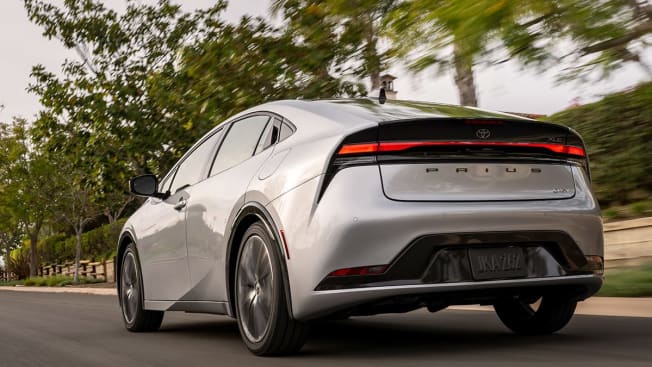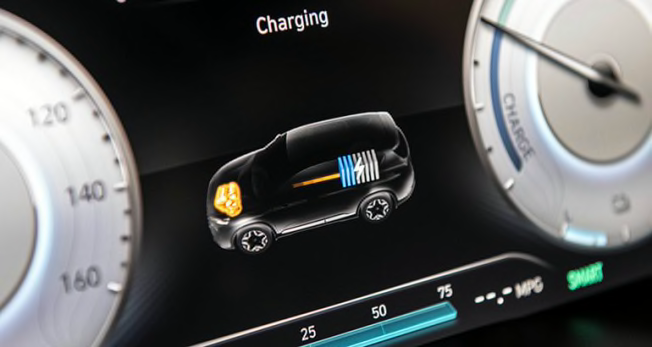How Do Hybrid Cars Work?
There’s lots of interest in fully electric cars, but hybrid vehicles also offer fuel savings and environmental benefits

At Consumer Reports, we often get asked if a hybrid car is gas or electric. In simple terms, the answer is yes to both—hybrids combine a gas engine, a battery, and an electric motor to get the benefits of both gas and electric propulsion. In addition, through their braking systems, hybrids can “recycle” kinetic energy that otherwise would have been wasted. Unlike fully electric vehicles, hybrids give off some tailpipe emissions, but they don’t need to be plugged in. That makes them a good choice for drivers who want to save fuel without going 100 percent electric.
Today’s hybrids come in all shapes and sizes, from compact hatchbacks to three-row SUVs. Many outperform their nonhybrid counterparts in CR’s road tests and do well in our reliability rankings as well. In addition, hybrid owners tell us that they really like their vehicles: In CR’s Annual Auto Surveys, they tend to report higher overall satisfaction than do owners of nonhybrid versions.
If you’re considering buying a hybrid—or just wondering how they work—we’ve got you covered.
A Brief History of Hybrids
Hybrids have been on sale in the U.S. since the 2000 model year, when the tiny, teardrop-shaped Honda Insight first hit North American dealerships. Its debut was closely followed by the Toyota Prius, which had been on sale in Japan since 1997. Soon, “hybrid” was shorthand for small, fuel-efficient hybrid sedans.
Since then, hybrid technology has become commonplace, with many common models offering a hybrid powertrain. Most of the time, vehicles are “hybridized” to improve their fuel economy, but some hybrids—such as the Ford F-150 Hybrid pickup—use their hybrid powertrains to provide additional electric power for towing or quicker acceleration.

Photo: Hyundai Photo: Hyundai
Hybrid Technology, Explained
Hybrids combine a gasoline engine, an electric motor, and a battery pack. The electric motor drives the car at low speeds (typically up to 30 mph, depending on how much charge the battery has) or under low power demands, while the gas engine kicks in at higher speeds where it’s more efficient and makes most of its power, or when you need to accelerate quickly or climb hills. Hybrids can drive on electric power alone for short distances, but often the engine and motor(s) operate together. There’s no need to plug the car in, because the gas engine recharges the car’s battery.
Hybrids are also equipped with regenerative brakes that capture momentum to create electricity as the car slows down or coasts. That electricity is also used to recharge the battery. By comparison, a regular car’s brakes just create friction that turns into unusable heat.
By supplementing the engine with an electric motor, the gas engine doesn’t need to be as big in order to achieve an overall combined horsepower rating that’s comparable to a gas-only car, which further increases efficiency.
“Hybrids are so fuel-efficient because they utilize energy that would otherwise be wasted,” says Jake Fisher, senior director of CR’s Auto Test Center. In fact, hybrids’ emissions are up to a third lower than comparable nonhybrids, according to CR’s calculations.
Although hybrids are more efficient overall than their gas-only counterparts, you can expect to see higher fuel economy in city driving (where the electric motor has more of an impact) than on long highway stretches at higher speeds. This is the opposite of what we’re accustomed to with conventional vehicles.
Hybrids Have Few Drawbacks
In older hybrids, drivers might have felt a slight shudder when the gas engine kicked in, and the regenerative braking system may have made it hard to ease into a stop. Most of those issues are gone now, and our exclusive vehicle testing shows that most of today’s hybrids tend to drive more smoothly and have more power than their nonhybrid counterparts.
A small consequence is that hybrids often use an electronic continuously variable transmission (eCVT), a form of CVT, which contributes to improved fuel economy but can also exhibit a monotone “droning” sound from the gas engine. In addition, drivers might notice a “flaring” sensation—where the engine suddenly seems to rev loudly and freely during highway merging or climbing a hill.
Despite the addition of all that extra technology, many hybrids cost about the same as their nonhybrid versions. If the hybrid does cost more, our analysis found that in many cases the monthly fuel savings will outweigh any increase in monthly payment, saving you money from day one. Hybrid batteries in many long-running models have proved to be reliable over decades and hundreds of thousands of miles. Consequently, hybrids tend to do well in our reliability ratings, too.
Read CR’s list of the hybrids that save you the most money.
Hybrids vs. EVs
Fully electric vehicles do not have a gasoline engine, and they need to be plugged in to recharge the battery. They can often go more than 200 miles on a charge and can be recharged at home or at public chargers.
However, recharging an EV takes much longer than gassing up a car—anywhere from 20 minutes to a few hours, depending on how many miles you need and how fast the charger you’re using is—and finding a charging station on the road isn’t as easy as finding a gas station. That makes hybrids more convenient for people who don’t live near EV charging stations, who can’t charge at home, or who often take long road trips.
CR’s analysis shows that pure electric vehicles are more efficient than hybrids, and often cost less to maintain and repair. They’re also often eligible for tax credits that hybrids can’t get. However, in some cases, a hybrid can cost less to own and operate than a similar electric vehicle. That’s especially true for small SUVs and compact cars, and even more so if you live somewhere with high electricity costs. A key reason: They cost less to purchase.
What About Plug-In Hybrids?
Unlike pure EVs or conventional hybrids, plug-in hybrid electric vehicles (PHEVs) operate like a hybrid but can be plugged into a wall outlet or EV charger, too. Fully charged, they can run on mostly electric power for about 20 to 40 miles (depending on the vehicle) until they switch back to regular hybrid operation. Unlike regular hybrids, a PHEV may be eligible for federal tax credits. Considering that the average American drives less than 40 miles per day, that means that some drivers will be able to do most of their daily travel on electric power, as long as they plug in first, while reserving the gas engine for longer trips.
However, because of the added weight of their larger batteries, motors, and onboard charging equipment, PHEVs tend to cost more and get worse mileage than a conventional hybrid once that electric charge has run dry. If you charge daily and have a short commute, you’d consume hardly any fuel. In all other situations your fuel consumption could be higher than the regular hybrid counterpart. A pure EV might be a better choice if you can charge at home and rarely drive long distances.
Is a Hybrid Right for You?
To recap, today’s hybrids can cost the same as or less than a comparable gas-powered vehicle—or at least save you money over time. Most are reliable and have high owner satisfaction ratings, and many drive better than their nonhybrid counterparts. They don’t need to be plugged in, and they can be filled up at any gas station.
If you’re considering buying a hybrid, check out our full ratings of hundreds of new and used vehicles to find the right one for your needs.
















